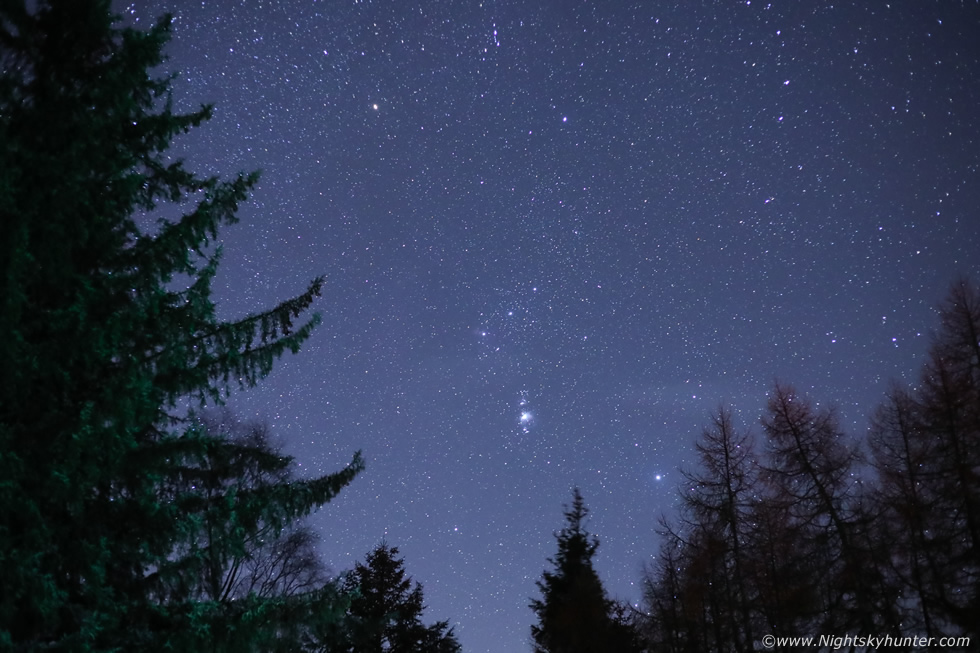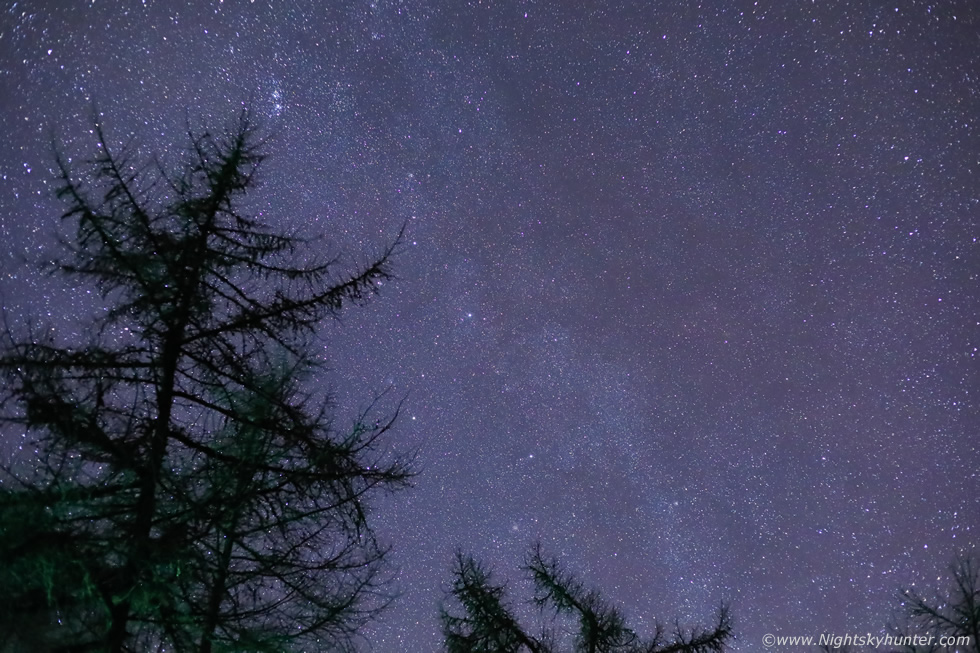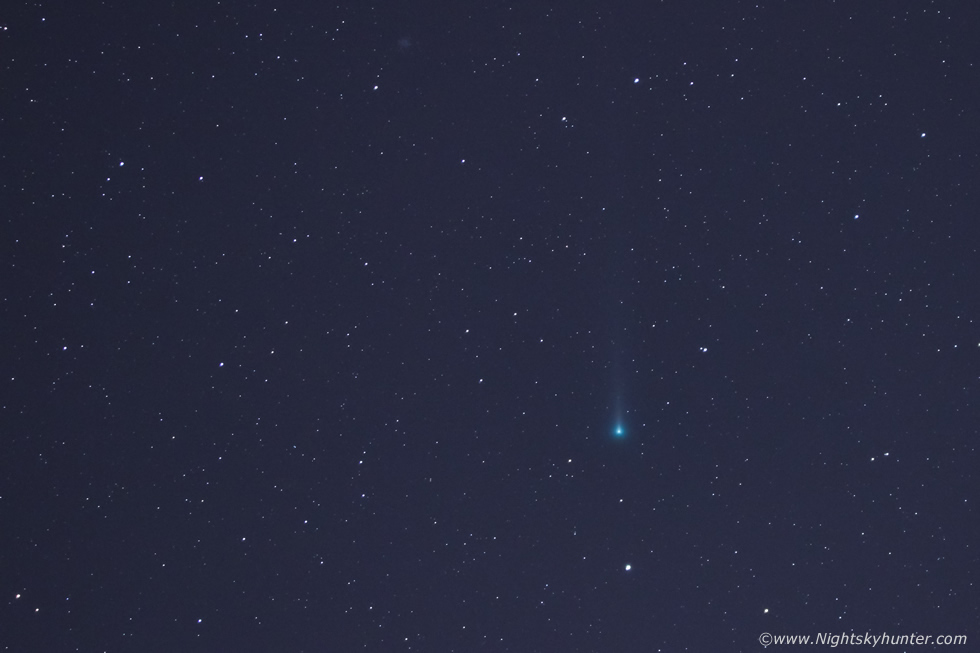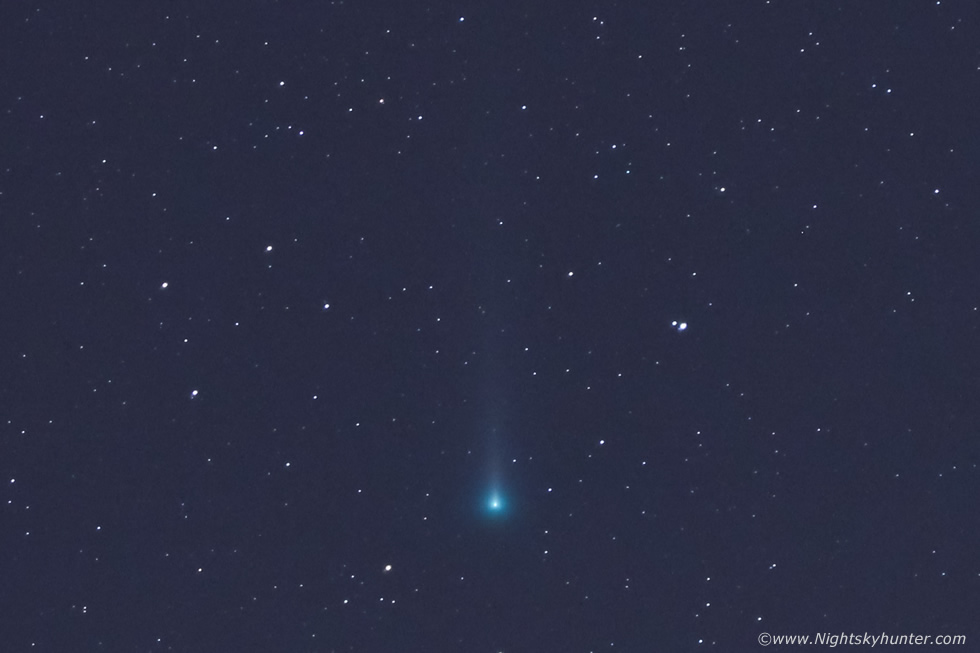
 |
Believe it or not I'm still buzzing after observing comet NEOWISE during the Summer of 2020, it was the brightest comet I've witnessed since Hale-Bopp in 1997 and even though NEOWISE didn't fall into the 'great' category it was still a beautiful naked eye comet, the sight of this golden visitor in the telescope embedded within drifting electric blue Noctilucent Clouds ranks as a very special and unique memory, in fact, I would consider NEOWISE to be one of the most beautiful sights I've ever seen in nature.
When the comet faded and moved south I resumed my observations of faint telescopic comets in the mag +10 to +12 range using my new Meade 10" F/5 truss tube reflector on a Dobsonian mount. During January of 2021 Gregory Leonard discovered a faint mag +19 comet which soon generated much interest among comet fans. This particular comet would pass fairly close to Earth a year later on December 12th 2021 and could become a binocular or even naked eye object. As the months passed the predications became more accurate, the northern hemisphere would have a front row seat to watch this new visitor brighten and make its closest approach before Christmas then the comet would dive south around the Sun and get ejected out from the solar system never to be seen by Human eyes again.
The comet was predicated to peak at mag +4 making it a naked eye object, however experts used models based on previous comets such as McNaught in 2007 to work out that the comet would experience a forward scattering event during mid December which could cause the comet to surge to mag +3 or even +2, there were even wilder suggestions of first magnitude being reached, this would most certainly turn Leonard into an obvious naked eye comet, furthermore as it crossed the Earth's orbit during this same period it could produce a rare anti-tail. I was rather excited, I never expected a great comet or even anything close to NEOWISE however I was expecting a promising object which would be mag +4 at least, so my intention was to devote as much time as possible to this comet once it came within range of my telescope then watch it evolve over time into a pleasant show during the run up to Christmas. During the first half of the year the comet was already exhibiting high concentrations of dust with an obvious coma and a dust tail even when far from the Sun, if this activity continued there was good reason to expect a decent show. The icing on the cake was that this was not its first visit into the inner solar system so the odds yet again seemed to favor a nice comet on the cards.
On November 21st/22nd I made my very first visual observation of C/2021 A1 Leonard, that morning I had rose at 04.30 UT and set up the 10" in the backyard at a location just at the edge of Cookstown, the sky was dark and moonless and 95% clear. I knew the comet was located low in the NE sky between Canes Venatici and Coma Berenices and even though I wasn't fully dark adapted I checked the alignment of my telrad then began sweeping through my target area, I literally found the comet within ten seconds!, the coma was oval in shape, sported a subtle green colour and at centre was a bright stellar central condensation, the DC: was 6, I could easily discern a dust tail 15 arc min's in length and make out faint streamers within the tail, I estimated the magnitude at +7.5, I followed the comet in the wide angle 2" 26mm eyepiece until 05.37 UT ending the session before dawn. This was my 80th comet observed visually. Amazingly after this morning N. Ireland was affected by the worst cloudy weather I had seen in a long time, thanks to cloud associated with warm fronts or simply cloudy high pressure periods, it seemed to last forever and during this time I missed watching the comet brighten.
 |
December 3rd/4th was my next attempt, the models indicated an intense cold front crossing the country during the first part of the night then clearing to scattered showers with good clear spells, this looked to be our best opportunity, the Moon was new so John Fagan and I agreed to meet up to dedicate the night to the comet. We met at the car park within Davagh Forest close to OM Dark Sky Park and Observatory, the front had cleared and the sky was absolutely immaculate, dark, transparent and simply outstanding, it was actually 100% clear for quite some time. We had arrived at midnight however the comet wouldn't rise until between 02.00 UT and 03.00 UT so we had time to kill.
I set up the full frame DSLR with 50mm F/1.8 lens and began shooting time lapse and stills of the starscapes over the tree tops. Orion looked stunning with his three belt stars boldly scintillating in a clearance between the trees, the scene was rather festive looking, this is an 8 sec exposure at ISO6400 stopped down to F/2.8, even at a casual glance you can see the famous Orion Nebula M42 with M43 and even the Flame Nebula, M78 is also present. As the camera captured images we got dark adapted then John and I set up our telescopes, we both had the same instrument which was cool, we observed a range of Messier objects then hunted down periodic comet 67P/Churyumov-Gerasimenko located high in the NE within Cancer to the south of a naked eye star, even though this comet had passed perihelion it was still a nice object in the 10" with a dust tail 10 arc min's in length, we estimated the magnitude at +10.2.
We were now ready for LEONARD, according to Stellarium it would be rising shortly, then the sky clouded over and it began to rain, heavily, we took shelter in the vehicles, it seemed relentless and didn't want to clear, I rested for a while in the heat and listened to Christmas music on Downtown radio, then it began to snow, I was rather enjoying the big wet snow flakes blowing past the headlights and fully expected it all to pass soon, then John signaled me and showed me the radar and satellite images, it looked like game over, a massive area of cloud was moving in from the NW and didn't look to clear until 07.00 UT or later, it was truly game over, we couldn't believe it, no forecast had predicted this cloud fest, we waited another thirty minutes then called it a night at 03.30 UT, at least the forecast looked much better for the following night.
On December 4th/5th I made my second observation of comet C/2021 A1 Leonard. I met up with John Fagan at Davagh Forest at the same location again and as luck would have it we got treated to one of the finest nights of the season. Thanks to cold air the sky was of exceptional clarity with transparency at 9/10. Using the Meade 10" F/5 reflector I began observing DSOs so I could get adjusted to the night, M42 in the scope was unbelievable with faint colour tones and impressive structure filling the FOV, even M1 the Crab Nebula had structure in the form of delicate filaments, the Flame Nebula had a clear division with structure and I even made an attempt to find the Horse Head Nebula, however no joy, I've yet to see this challenging object visually.
Leonard would soon be rising, it was a cold breezy night however John and I were sheltered among the trees so observing was quite pleasant despite the cold wet ground, I began searching low in the NE, I picked up globular cluster M3, I knew the comet was SE of this object but not quite visible yet. I waited another thirty minutes then began a careful sweep once again, I chose a region of sky to the E of Arcturus within Bootes and at 01.55 UT I swept up Leonard only 5 degrees above the local horizon, it shared the FOV with distant tree tops. I was impressed, considering the extremely low elevation and atmospheric extinction the comet was bright and obvious in the field, I could even see a segment of the tail, I half jokingly said to John that this should be a nice object when it rose higher and I even suggested I would try for it with the naked eye, however both of us didn't take that part seriously.
One hour later at 03.00 UT the comet was higher and viewed in a very clear sky, in the telescope it was rather beautiful in a subtle way, I measured the tail at 1 degree in length with streamers inside, the coma was 8 arc min's in diameter at DC: 6, the central condensation was bright with structures inside the coma close to the CC to the east and west, these were enhancements where the nucleus was producing intense activity, I didn't classify these as jets but did suggest they were fan-like. The coma was green with a white core and the tail was aquamarine blue-green, it looked ghostly against the background stars. Then after a long period of careful observation using averted vision and being patient I observed Leonard with the naked eye, it popped in and out of view half a dozen times during the session, its fuzzy coma was on the naked eye limit and close to a bright naked eye star, however I could see the tail without optical aid as a thin streak extending to the N or perhaps slanted slightly to the E of N. My brightness estimate was mag+6.2.
 |
As the sky was so incredible I took a few more images of the stars with the full frame and 50mm F/1.8 lens, this was 9 sec's at F/2.8 ISO8000, untracked image of the Milky Way, Cassiopeia can be seen near centre. The Double Cluster is to the upper left and the stars of Cepheus to the lower right. Just look at the amount of stars in this short exposure, it makes you wonder who many intelligent civilizations are living on planets around distant suns within our galaxy, perhaps some of them are in this image.
 |
John let me use his sky tracker and at 04.30 UT I was able to get my first image of this comet, I was using a Canon 600D crop sensor at ISO1600 with an exposure of 87 seconds on a telephoto lens at 150mm F/5, the first image is the original size and the second a crop from the same still. At 05.00 UT we called it a night, it had been a complete success, we visually observed Leonard and captured it on camera from a very dark site while in the company of numerous meteors, some of which were Geminids.
 |
Little would I know that thanks to more cloudy weather that these would be the first and last images of comet Leonard which I would get, at this stage the comet was eight days from its closest approach to Earth and already moving at 42km/sec, it was picking up speed every day and by perihelion in January it will be moving at a velocity of 70km/sec. The following day one other naked eye report came in from another experienced comet observer from another part of the world confirming my sighting, however not many seen it, and very few actually saw it at all from Ireland, you could count the number of observers with one hand from this weekend and into the coming week. John and I decided that if we never saw it again then we were happy and content, we had obtained a visual sight, a fine memory and images of a comet we shall never see again, at 05.00 UT we called it a night and headed home to a much welcomed warm bed.
My third and last observation was on December 9th/10th from 06.00 to 06.50 UT from back in my yard near Cookstown. This was a cold wind swept morning, the moon had set and the sky was dark however the comet was much lower in the sky so I had to wait for the area of interest to clear the low garage rooftop. The sky was not great with transparency 5-6/10 and seeing 5/10, there was also thin high level cloud present, the seeing varied dramatically, at times the stars were points of light then seconds later they had swollen into out of focus blobs, this was a testament to how unsteady the atmosphere was, no doubt due to changing weather and the jet stream moving in ahead of a wind storm the following day.
I found Leonard easily low in the NE below the Serpent's Head in Serpens Caput, in the 10" the coma was 10 arc min's wide, however I could see no colour, just a pastel grey with white condensation at centre, however Leonard did look like a proper comet, telescopically anyway, bright and ghostly, DC:5 and the long grey-white tail was 1 and 1/4 degrees in length, I had to sweep the scope north to observe the fainter extremities of the tail. A multitude of fine streamers emanated from the coma into the first section of the tail, these were beautiful, I also perceived an enhancement within the coma on the sunward side. Then, with great difficulty I could see the comet with the naked eye from my back garden, mag +5.0, the coma looked much larger without optical aid, perhaps 15 arc min's or half the apparent size of the full moon. The brightening sky ended my session and as the first birds of dawn began singing I ended the session feeling content.
Thanks to an abundance of cloudy weather this was my final observation of C/2021 A1 Leonard. I followed the developments closely on social media from imagers who had clear skies in other parts of the world. The gas and dust tails did improve on CCD images however the forward scattering event didn't do a lot as the comet was dominated largely by gas, the dust output seemed to have curtailed sometime ago so for this reason the comet didn't surge by many magnitudes. At the time of writing (December 13th) the comet is more or less gone from my latitude, it simply is too low in the SW evening sky close to the horizon, it's close to the west of planet Venus however the comet is simply not bright enough to compete against the strong twilight glow after sunset. The tail should sweep over Venus, experts say it could produce a meteor shower in the planet's atmosphere, wouldn't it be great to be in a spaceship to watch the show. Leonard is now moving south and will soon be picked up by observers in the southern hemisphere, I look forward to seeing what they make of it.
Leonard didn't become the obvious naked eye comet we had hoped for, this isn't shocking, comets never do what anyone wants or expect them to do, even in this day of modern technology and with or greater understanding of comets we still don't know what any given comet will do, David Levy's famous quote will always stand the test of time... ''comets are like cats, they have tails and do precisely what they want''. I still enjoyed Leonard, sometimes the hunt is what forges the best memories with these visitors, and with that being said I'm eagerly anticipating the discovery of the next great comet in the northern hemisphere, we are long overdue so I'm sure our patience will be rewarded in due course. Thanks very much for reading.
Martin McKenna